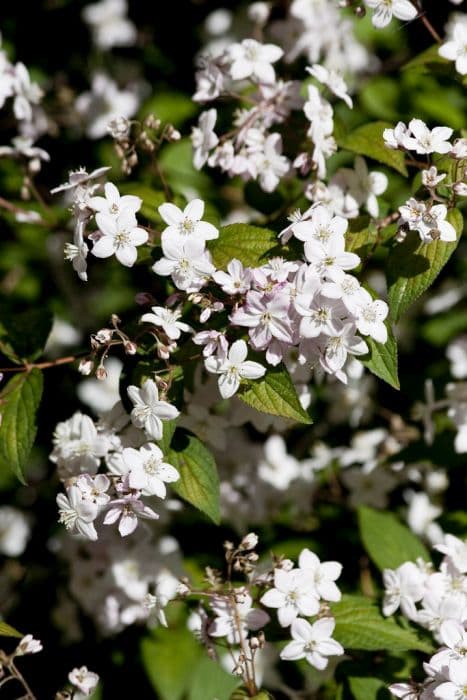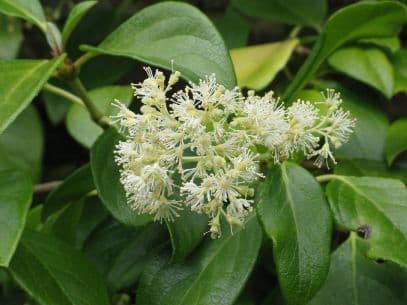Hydrangea Hydrangea 'Dharuma'

ABOUT
Hydrangea 'Dharuma' is characterized by its attractive and voluminous flower heads that come in a variety of hues depending on the soil pH, ranging from pink to blue or purple. These mophead flowers exhibit a rich, saturated color and are often densely packed with tiny, star-shaped individual blooms that create a fluffy, round appearance reminiscent of pom-poms. The bloom time typically falls in summer, providing a long season of visual interest. The leaves of Hydrangea 'Dharuma' are broad and have a deep green color, offering a lush backdrop for the vibrant flowers. The foliage has a glossy texture and is often heart-shaped or ovate, coming to a point at the tip and featuring serrated edges. The plant's overall form is bushy and fills out with a good number of stems, creating a robust and opulent display in the garden. It can become a focal point in any landscape design given its striking floral presentation and substantial foliage presence. The stems of the plant are sturdy enough to support the weight of the flowers, which can be heavy when in full bloom. Overall, Hydrangea 'Dharuma' is an ornamental plant that provides a bold pop of color and a classic aesthetic that can complement a wide range of garden styles.
About this plant
 Names
NamesSynonyms
Daruma Hydrangea, Dwarf Hydrangea, Japanese Hydrangea.
Common names
Hydrangea 'Daruma'
 Toxicity
ToxicityTo humans
Hydrangea, including the 'Dharuma' cultivar, contains compounds that are toxic when ingested. The plant has cyanogenic glycosides, which can release cyanide in the body. Symptoms of hydrangea poisoning typically include gastrointestinal upset, such as nausea, vomiting, and diarrhea. In some cases, more severe symptoms might occur, like dizziness, confusion, and increased heart rate. It is advisable to seek medical attention if any part of the hydrangea is consumed.
To pets
Hydrangea can be toxic to pets if ingested. Similar to its effects in humans, the plant contains cyanogenic glycosides that can release cyanide in the body. Symptoms of poisoning in pets may include vomiting, diarrhea, lethargy, and depression. In more severe cases, symptoms might escalate to include rapid heartbeat and seizures. If you suspect your pet has ingested hydrangea, it is important to contact a veterinarian immediately.
 Characteristics
CharacteristicsLife cycle
Perennials
Foliage type
Deciduous
Color of leaves
Green
Flower color
Varies
Height
3 feet [0.91 meters]
Spread
3 feet [0.91 meters]
Plant type
Shrub
Hardiness zones
Varies
Native area
Asia
Benefits
 General Benefits
General Benefits- Ornamental Appeal: Hydrangea 'Dharuma' has large, attractive flowers that provide visual interest in garden landscapes and as cut flowers within homes.
- Color Variety: The blooms can change color based on soil pH, from pink to blue, adding diversity and a dynamic quality to gardens.
- Seasonal Interest: With a long blooming season from late spring to fall, Hydrangeas offer extended periods of garden interest.
- Bee and Butterfly Attraction: The flowers attract pollinators such as bees and butterflies, helping to support local ecosystems.
- Shade Tolerance: Hydrangea 'Dharuma' can tolerate partial shade, making them suitable for a variety of garden settings where other plants might struggle.
- Easy Propagation: Hydrangeas can be propagated through cuttings, division, or layering, making them easy to share with friends or expand in the garden.
- Durable: They are relatively hardy and can withstand different climates and conditions with appropriate care.
- Soil Adaptability: While they prefer well-draining, moist soil, they can adapt to various soil types.
- Mood Improvement: Their lush blooms and rich foliage can boost the aesthetic of any space, which can contribute to emotional well-being.
 Medical Properties
Medical PropertiesThis plant is not used for medical purposes.
 Air-purifying Qualities
Air-purifying QualitiesThis plant is not specifically known for air purifying qualities.
 Other Uses
Other Uses- Hydrangea Dharuma petals can be pressed and included in artwork or crafts for their vibrant color and unique texture.
- The bark of Hydrangea Dharuma can be used in the creation of certain types of Japanese washi paper, lending it a distinctive appearance.
- Dried Hydrangea Dharuma flowers can serve as a natural desiccant when added to containers of homemade potpourri to absorb excess moisture.
- The wood of the Hydrangea Dharuma can be carved into small ornamental figures or used in intricate woodworking projects.
- The blooms can be used as a natural dye for fabrics, yielding colors from pale blue to pink depending on the pH of the soil they were grown in.
- Hydrangea Dharuma can be used in a living fence or privacy screen due to its dense foliage and shrubby growth habit.
- During certain traditional Japanese festivals, hydrangea flowers including Hydrangea Dharuma may be floated in bowls of water as a decorative element.
- The large leaves can be used to wrap small items, such as homemade candies or gifts, as a biodegradable and decorative packaging material.
- Gardeners may use spent Hydrangea Dharuma blooms as a natural indicator of soil pH, as the color variation of the blooms can give clues about the soil conditions.
- Deadheading Hydrangea Dharuma's spent blooms can be a therapeutic horticultural activity, providing an opportunity for mindfulness and connection with nature.
Interesting Facts
 Feng Shui
Feng ShuiThe Hydrangea is not used in Feng Shui practice.
 Zodiac Sign Compitability
Zodiac Sign CompitabilityThe Hydrangea is not used in astrology practice.
 Plant Symbolism
Plant Symbolism- Heartfelt Emotions: The Hydrangea is often associated with the expression of deep and sincere emotions when given as a gift.
- Gratitude: With its abundant blooms, it symbolizes the giver’s gratitude and thankfulness towards the recipient.
- Apology: A bouquet of Hydrangeas might be sent as a way to express an earnest apology, representing regret and a desire for forgiveness.
- Understanding: Some believe that Hydrangeas represent an understanding between people, making it a suitable gift for friends and loved ones.
- Vanity: In certain contexts, Hydrangeas may denote vanity or boastfulness due to their showy and elaborate flowers.
- Abundance and Prosperity: The lush nature of the Hydrangea's flowers can be symbolic of abundance and prosperity.
 Water
WaterBigleaf hydrangeas like the 'Dharuma' prefer consistently moist soil, so water deeply once a week, providing about 1 gallon of water for each plant. During hot and dry periods, you may need to water twice weekly. Avoid overhead watering to reduce the risk of leaf diseases; instead, water at the base of the plant. It's essential to ensure proper drainage as overwatering can lead to root rot. Adjust the frequency based on your climate and weather conditions, monitoring the soil moisture level regularly.
 Light
Light'Dharuma' hydrangea, like other bigleaf hydrangeas, thrives in partial shade, especially in the afternoon. Morning sun with dappled afternoon shade is ideal to protect it from intense heat, which can scorch the leaves. It can tolerate full sun in cooler climates if it's kept sufficiently watered but generally performs best with protection from harsh midday rays.
 Temperature
TemperatureThe bigleaf hydrangea 'Dharuma' prefers a temperature range between 65°F and 75°F but can tolerate down to about 50°F and up to 80°F. Temperatures below freezing can damage new growth, so winter protection in colder zones is necessary. Proper mulching can help insulate roots from sudden temperature drops.
 Pruning
PruningPrune your 'Dharuma' bigleaf hydrangea annually to maintain shape and encourage vigorous growth. The optimal pruning time is after blooming in mid-summer, as hydrangeas bloom on old wood. Remove dead or weak stems, and thin out crowded areas to improve air circulation. Pruning in late winter or early spring can remove flower buds and diminish blooming for the season.
 Cleaning
CleaningAs needed
 Soil
SoilThe best soil mix for a Hydrangea, commonly called hydrangea, should be rich, moist, and well-draining, with a high organic matter content such as compost or peat moss. The soil pH for hydrangeas should be acidic to slightly acidic, around 5.5 to 6.5, to help maintain the vibrant bloom colors.
 Repotting
RepottingHydrangeas should be repotted every 2 to 3 years or when the root system outgrows the current container. Choose a slightly larger pot and fresh potting mix to ensure the plant continues to thrive.
 Humidity & Misting
Humidity & MistingHydrangeas prefer moderate to high humidity levels, typically between 60% to 70%, which is necessary to support their lush foliage and robust blooms.
 Suitable locations
Suitable locationsIndoor
Provide bright indirect light and maintain even moisture.
Outdoor
Plant in morning sun, afternoon shade; keep soil moist.
Hardiness zone
5-9 USDA
 Life cycle
Life cycleThe Hydrangea 'Dharuma', commonly known as the Dwarf Hydrangea, begins its life cycle as a seed that germinates in moist, well-drained soil in partial to full sun. After germination, the seedling grows into a young plant with distinctive foliage and begins to develop a root system. As it matures, the Dwarf Hydrangea enters a vegetative stage, producing lush leaves and eventually woody stems. The reproductive stage follows, typically in early to mid-summer, when the plant blooms with large, showy flower heads that can range from pink to blue depending on soil pH. After pollination, the flowers may produce seeds that can disperse to propagate new plants, completing the cycle. In autumn, the Hydrangea 'Dharuma' may experience a period of dormancy, losing its leaves in colder climates before resuming growth in the spring.
 Propogation
PropogationPropogation time
Spring-Early Summer
Propogation: The Hydrangea macrophylla 'Dharuma', commonly known as lacecap hydrangea, is typically propagated through stem cuttings. The most popular method involves taking a cutting from a healthy, non-flowering shoot in early to mid-summer when the plant's growth is vigorous. You should choose a stem that has several sets of leaves and make the cut just below a leaf node, about 5 to 6 inches (approximately 12.7 to 15.24 centimeters) long. Remove the lower leaves and dip the cut end in rooting hormone to promote root development. Then, insert the cutting into a pot with well-draining soil mix and water it thoroughly. The pot should be kept in a warm, humid environment with indirect sunlight until roots have developed, which usually takes about 2 to 4 weeks. Regular misting can help maintain humidity, which is crucial for successful rooting.





![Hydrangea [Pink Annabelle] ('Ncha1')](/_next/image?url=https%3A%2F%2Fplants-admin.emdemapps.com%2Fimages%2Fplants%2F%2Fimages%2F604b576c63619.png&w=640&q=75)



